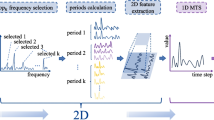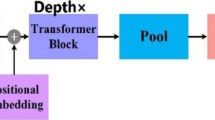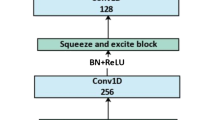Abstract
Time series classification is related to many different domains, such as health informatics, finance, and bioinformatics. Due to its broad applications, researchers have developed many algorithms for this kind of tasks, e.g., multivariate time series classification. Among the classification algorithms, k-nearest neighbor (k-NN) classification (particularly 1-NN) combined with dynamic time warping (DTW) achieves the state of the art performance. The deficiency is that when the data set grows large, the time consumption of 1-NN with DTWwill be very expensive. In contrast to 1-NN with DTW, it is more efficient but less effective for feature-based classification methods since their performance usually depends on the quality of hand-crafted features. In this paper, we aim to improve the performance of traditional feature-based approaches through the feature learning techniques. Specifically, we propose a novel deep learning framework, multi-channels deep convolutional neural networks (MC-DCNN), for multivariate time series classification. This model first learns features from individual univariate time series in each channel, and combines information from all channels as feature representation at the final layer. Then, the learnt features are applied into a multilayer perceptron (MLP) for classification. Finally, the extensive experiments on real-world data sets show that our model is not only more efficient than the state of the art but also competitive in accuracy. This study implies that feature learning is worth to be investigated for the problem of time series classification.
Similar content being viewed by others
References
Xing Z, Pei J, Keogh E. A brief survey on sequence classification. ACM SIGKDD Explorations Newsletter, 2010, 12(1): 40–48
Ding H, Trajcevski G, Scheuermann P, Wang X, Keogh E. Querying and mining of time series data: experimental comparison of representations and distance measures. Proceedings of the VLDB Endowment, 2008, 1(2): 1542–1552
Orsenigo C, Vercellis C. Combining discrete svm and fixed cardinality warping distances for multivariate time series classification. Pattern Recognition, 2010, 43(11): 3787–3794
Batal I, Sacchi L, Bellazzi R, Hauskrecht M. Multivariate time series classification with temporal abstractions. In: Proceedings of FLAIRS Conference. 2009
Haselsteiner E, Pfurtscheller G. Using time-dependent neural networks for EEG classification. IEEE Transactions on Rehabilitation Engineering, 2000, 8(4): 457–463
Kampouraki A, Manis G, Nikou C. Heartbeat time series classification with support vector machines. IEEE Transactions on Information Technology in Biomedicine, 2009, 13(4): 512–518
Reiss A, Stricker D. Introducing a modular activity monitoring system. In: Proceedings of IEEE Annual International Conference on Engineering in Medicine and Biology Society. 2011, 5621–5624
Batista G E A P A, Wang X, Keogh E J. A complexity-invariant distance measure for time series. In: Proceedings of SIAM Conference on Data Mining. 2011
Rakthanmanon T, Campana B, Mueen A, Batista G, Westover B, Zhu Q, Zakaria J, Keogh E. Searching and mining trillions of time series subsequences under dynamic time warping. In: Proceedings of the 18th ACM SIGKDD International Conference on Knowledge Discovery and Data Mining. 2012, 262–270
Xi X, Keogh E J, Shelton C R, Wei L, Ratanamahatana C A. Fast time series classification using numerosity reduction. In: Proceedings of the 23rd International Conference on Machine Learning. 2006, 1033–1040
Bengio Y, Courville A, Vincent P. Representation learning: a review and new perspectives. IEEE Transactions on Pattern Analysis and Machine Intelligence, 2013, 35(8): 1798–1828
LeCun Y, Bengio Y. Convolutional networks for images, speech, and time series. The Handbook of Brain Theory and Neural Networks, 1995, 3361(10)
LeCun Y, Kavukcuoglu K, Farabet C. Convolutional networks and applications in vision. In: Proceedings of IEEE International Symposium on Circuits and Systems. 2010, 253–256
Zheng Y, Liu Q, Chen E, Ge Y, Zhao J. Time series classification using multi-channels deep convolutional neural networks. In: Proceedings of the 15th International Conference on Web-Age Information Management. 2014, 298–310
Hu B, Chen Y, Keogh E. Time Series Classification under More Realistic Assumptions. In: Proceedings of SIAM International Conference on Data Mining. 2013, 578
Goldberger A L, Amaral L A N, Glass L, Hausdorff J M, Ivanov P C, Mark R G, Mietus J E, Moody G B, Peng C K, Stanley H E. Physiobank, Physiotoolkit, and Physionet omponents of a new research resource for complex physiologic signals. Circulation, 2000, 101(23): e215–e220
Ye L, Keogh E. Time series shapelets: a new primitive for data mining. In: Proceedings of the 15th ACM SIGKDD International Conference on Knowledge Discovery and Data Mining. 2009, 947–956
Ratanamahatana C A, Keogh E. Making time-series classification more accurate using learned constraints. In: Proceedings of SIAM International Conference on Data Mining. 2004
Ratanamahatana C A, Keogh E. Three myths about dynamic time warping data mining. In: Proceedings of SIAM International Conference on Data Mining. 2005, 506–510
Yu D, Yu X, Hu Q, Liu J, Wu A. Dynamic time warping constraint learning for large margin nearest neighbor classification. Information Sciences, 2011, 181(13): 2787–2796
LeCun Y, Bottou L, Bengio Y, Haffner P. Gradient-based learning applied to document recognition. Proceedings of the IEEE, 1998, 86(11): 2278–2324
Simard P Y, Steinkraus D, Platt J C. Best practices for convolutional neural networks applied to visual document analysis. In: Proceedings of the 7th International Conference on Document Analysis and Recognition. 2003, 958–962
Nair V, Hinton G E. Rectified linear units improve restricted boltzmann machines. In: Proceedings of the 27th International Conference onMachine Learning. 2010, 807–814
Zeiler M D, Ranzato M, Monga R, Mao M, Yang K, Le Q, Nguyen P, Senior A, Vanhoucke V, Dean J, Hinton G E. On rectified linear units for speech processing. In: Proceedings of IEEE International Conference on Acoustics, Speech and Signal Processing. 2013, 3517–3521
Scherer D, Müller A, Behnke S. Evaluation of pooling operations in convolutional architectures for object recognition. In: Proceedings of the 20th International Conference on Artificial Neural Networks. 2010, 92–101
Nagi J, Ducatelle F, Di Caro G A, Ciresan D, Meier U, Giusti A, Nagi F, Schmidhuber J, Gambardella L M. Max-pooling convolutional neural networks for vision-based hand gesture recognition. In: Proceedings of IEEE International Conference on Signal and Image Processing Applications. 2011, 342–347
LeCun Y, Bottou L, Orr G B, Müller K R. Efficient backprop. Lecture Notes in Computer Science, 2012, 7700: 9–48
Bouvrie J. Notes on convolutional neural networks. Technical Report. 2006
Krizhevsky A, Sutskever I, Hinton G. Imagenet classification with deep convolutional neural networks. In: Proceedings of Advances in Neural Information Processing Systems. 2012, 1106–1114
Sutskever I, Martens J, Dahl G, Hinton G. On the importance of initialization and momentum in deep learning. In: Proceedings of the 30th International Conference on Machine Learning. 2013, 1139–1147
Erhan D, Bengio Y, Courville A, Manzagol P A, Vincent P, Bengio S. Why does unsupervised pre-training help deep learning? The Journal of Machine Learning Research, 2010, 11: 625–660
Hinton G E, Salakhutdinov R R. Reducing the dimensionality of data with neural networks. Science, 2006, 313(5786): 504–507
Masci J, Meier U, Cireşan D, Schmidhuber J. Stacked convolutional auto-encoders for hierarchical feature extraction. Lecture Notes in Computer Science, 2011, 6791: 52–59
Pinto N, Cox D D, DiCarlo J J. Why is real-world visual object recognition hard? PLoS Computational Biology, 2008, 4(1): e27
Cireşan D C, Meier U, Masci J, Gambardella L M, Schmidhuber J. Flexible, high performance convolutional neural networks for image classification. In: Proceedings of the 22nd International Joint Conference on Artificial Intelligence. 2011, 1237–1242
Cireşan D, Meier U, Masci J, Schmidhuber J. Multi-column deep neural network for traffic sign classification. Neural Networks, 2012, 32: 333–338
Lines J, Davis L M, Hills J, Bagnall A. A shapelet transform for time series classification. In: Proceedings of the 18th ACM SIGKDD International Conference on Knowledge Discovery and Data Mining. 2012, 289–297
Nanopoulos A, Alcock R O B, Manolopoulos Y. Feature-based classification of time-series data. International Journal of Computer Research, 2001, 10(3)
Lee H, Grosse R, Ranganath R, Ng A Y. Convolutional deep belief networks for scalable unsupervised learning of hierarchical representations. In: Proceedings of the 26th Annual International Conference on Machine Learning. 2009, 609–616
Lee H, Largman Y, Pham P, Ng A Y. Unsupervised feature learning for audio classification using convolutional deep belief networks. In: Proceedings of Advances in Neural Information Processing Systems. 2009, 1096–1104
Waibel A, Hanazawa T, Hinton G, Shikano K, Lang K J. Phoneme recognition using time-delay neural networks. IEEE Transactions on Acoustics, Speech and Signal Processing, 1989, 37(3): 328–339
Author information
Authors and Affiliations
Corresponding author
Additional information
Yi Zheng received his BE in Computer Science and Technology from Harbin Institute of Technology, China in 2009. He is currently a PhD student in the School of Computer Science and Technology at University of Science and Technology of China (USTC), China. His major research interests include time series data mining and deep learning. He has published several papers in refereed conference proceedings and journals, such as WAIM’14, PAKDD’15 and Nature Communications.
Qi Liu is an associate researcher in University of Science and Technology of China (USTC), China. He received his PhD in Computer Science from USTC. His general area of research is data mining and knowledge discovery. He has published prolifically in refereed journals and conference proceedings, e.g., TKDE, TOIS, TKDD, TIST, SIGKDD, IJCAI, ICDM, and CIKM. He has served regularly in the program committees of a number of conferences, and is a reviewer for the leading academic journals in his fields. He is a member of ACM and IEEE. Dr. Liu is the recipient of the ICDM’11 Best Research Paper Award, the Special Prize of President Scholarship for Postgraduate Students, Chinese Academy of Sciences (CAS) and the Distinguished Doctoral Dissertation Award of CAS.
Enhong Chen received his PhD in Computer Science from University of Science and Technology of China (USTC), China, his MS from Hefei University of Technology, China and his BS from Anhui University, China. He is currently a professor and the vice dean of the School of Computer Science, the vice director of the National Engineering Laboratory for Speech and Language Information Processing of USTC, winner of the National Science Fund for Distinguished Young Scholars of China. His research interests include data mining and machine learning, social network analysis and recommender systems. He has published lots of papers on refereed journals and conferences, including IEEE TKDE, TMC, KDD, ICDM, NIPS, CIKM and Nature Communications. He was on program committees of numerous conferences including KDD, ICDM, SDM. He received the Best Application Paper Award on KDD’08 and Best Research Paper Award on ICDM’11. He is a senior member of the IEEE.
Yong Ge received his PhD in Information Technology from Rutgers, The State University of New Jersey, USA in 2013, hisMS in Signal and Information Processing from the University of Science and Technology of China (USTC), China in 2008, and his BE in Information Engineering from Xi’an Jiao Tong University, China in 2005. He is currently an assistant professor at the University of North Carolina at Charlotte, USA. His research interests include data mining and business analytics. He has published prolifically in refereed journals and conference proceedings, such as IEEE TKDE, ACM TOIS, ACM TKDD, ACMTIST, ACMSIGKDD, SIAM SDM, IEEE ICDM, and ACM RecSys.
J. Leon Zhao is the Head and Chair Professor in the Department of Information Systems, City University of Hong Kong, China. He was Interim Head and Eller Professor in Management Information Systems, University of Arizona, USA. He holds PhD from Haas School of Business, University of California at Berkeley, USA. His research is on information technology and management, with a particular focus on collaboration and workflow technologies and business information services. He is director of Lab on Enterprise Process Innovation and Computing funded by NSF, RGC, SAP, and IBM among other sponsors. He received IBM Faculty Award in 2005 and was awarded Chang Jiang Scholar Chair Professorship at Tsinghua University in 2009.
Rights and permissions
About this article
Cite this article
Zheng, Y., Liu, Q., Chen, E. et al. Exploiting multi-channels deep convolutional neural networks for multivariate time series classification. Front. Comput. Sci. 10, 96–112 (2016). https://doi.org/10.1007/s11704-015-4478-2
Received:
Accepted:
Published:
Issue Date:
DOI: https://doi.org/10.1007/s11704-015-4478-2




